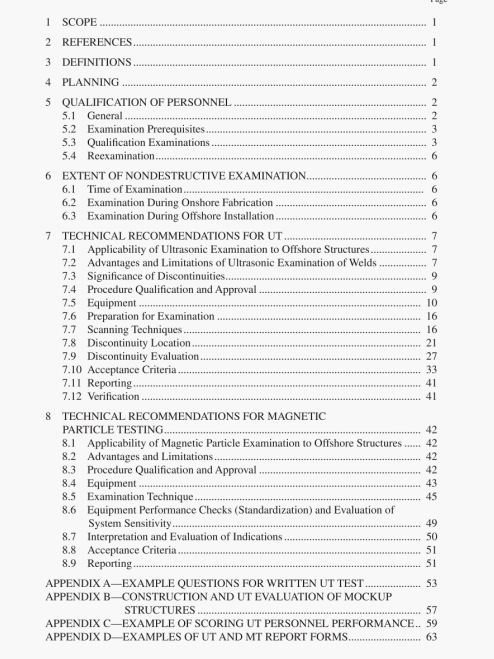API RP 2X:2004 pdf download.Recommended Practice for Ultrasonic and Magnetic Examination of Offshore Structural Fabrication and Guidelines for Qualification of Technicians.
The beam produced from this probe will permit examination of thick sections with moderate beam decay. resolve most discontinuities of interest WithoUt indicating the presence of tine inclusions within the steel, and exhibit a beam profile included angle sufficiently broad to ensure that discontinuities at all orientations between the nominal 45- degrees. 60-degrees, and 70-degrees angles will yield a significant echo signal. Other transducer frequencies and sizes may be desirable for specific applications.
7.7.2 Sen&tivity
Scanning must ensure the detection of all discontinuities of interest: therefore, a Sensitivity greater than that required to produce a lull-scale echo signal from the reference reflector is always employed. An increase in sensitivity 6 decibels above that required to produce a full-DAC echo signal from the reference reflector will ensure full-DAC echo signals for discontinuiiies oriented seven to ten degrees from perpendicular when scanning with the recommended probe. An additional increase of 6 decibels (12 decibels total) above the reference will aid in detection of transient reflectors a high scanning speeds. Higher scanning sensitivities are desired by some UT personnel. but caution should be exercised to avoid large echo signals froni insignificant or irrelevant discontinLlities which resull in lime—consuming evaluations and promotes eye fatigue.
7.7.3 Extent of Coverage
7.7.3.1 The complex geometry of welded connections on offshore structure particularly T, K. and Y connections, typically requires the use of nominal angle transducers (i.e.. 45- degree, 60-degree, and 70-degree) in multiple scans of the entire circumference and almost always from the brace side of the weld only. The inspection of thin wall sections may not improve with the use of steer angle transducers. Thick wall diagonal braces with full-throated weld connections may also require the use of an 80-degree transducer to ensure that the sound beam intercepts the root area. In all scans the transducer cant angle is continually adjusted to maintain the beam perpendicular to the length of the weld. See Figure 14 for definitions of nomenclature associated with tubular member intersections. The recommended effective probe angle for examination of the root area should be that which produces an incident angle nearest to perpendicular to the anticipated weld discontinuity. UT personnel are cautioned in be alert for changes in intercept angles and avoid 30-degree incidence on potential discontinuities which cause mode conversion and a loss of echo signal amplitude. (See Section 7.8 for the effects of surface geometry on the incident angle.)
API RP 2X:2004 pdf download
